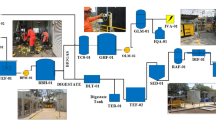Abstract
The anaerobic bioconversion of municipal solid wastes (MSW) produces both a valuable fuel product (methane) and a residue useful as a soil amendment. The application of high-solids fermentation technology offers improved economics over the more traditional low-solids fermentation systems. An important benefit of the high-solids process is the reduction in process water, which results in smaller fermentation reactors, and thus lower capital and operating costs. However, the anaerobic bioconversion process appears to be more efficient at high-solids as compared to low-solids levels. To understand the effects of solids levels on the anaerobic bioconversion process more thoroughly, representative high-solids and low-solids anaerobic reactor systems processing identical MSW feedstocks are compared with respect to fermentation performance, total microbial cell number, and important hydrolytic enzyme activities.
Similar content being viewed by others
References
Schwartz, S. C. and Brunner, C. R. (1983),Energy and Resource Recovery from Waste, Noyes Data Corp., New Jersey.
US Environmental Protection Agency (1974),Third Report to Congress, Pub. No. SW-161, Washington, D.C.
Boone, D. R. (1982),Appl. Environ. Microbiol. 43, 57.
Noike, T., Endo, G., Chang, J.-E., Yaguchi, J.-I., Matsumoto, J.-I. (1985),Biotechnol. Bioeng. 27, 1482.
Biljetina, R., Srivastava, V. J., Fannin, K. F., Janulis, J. A., and Henry, M. P. (1987),Annual Report for Walt Disney Imagineering, Contract No. 9MP-86-1.
Stenstrom, M. K., Ng, A. S., Bhunia, P. K., and Abramson S. D. (1983),J. Environ. Eng. 109, 1148.
Verachtert, H., Ramasamy, K., Meyers, M., and Bevers, J. (1982),J. Appl. Bacteriol. 52, 185.
Vinzant, T. B., Adney, W. S., Grohmann, K., and Rivard, C. J. (1990),Appl. Biochem. Biotech. 24/25, 765.
Gujer, W. and Zehnder, A. J. B. (1983),Wat. Sci. Tech. 15, 127.
Gijzen, H. J., Zwart, K. B., Teunissen, M. J., and Vogels, G. D. (1988),Biotech. Bioeng. 32, 749.
Clanet, M. and Durand, H. (1988),Biotech. Bioeng. 32, 930.
Adney, W. S., Rivard, C. J., Grohmann, K., and Himmel, M. E. (1989),Biotech. Apl. Biochem. 11, 387.
Rivard, C. J., Adney, W. S., and Himmel, M. E. (1991),Enzymes in Biomass Conversion, Leatham, G. and Himmel, M. E., eds., American Chemical Society Books, Washington, D.C.
Rivard, C. J., Vinzant, T. B., Adney, W. S., Grohmann, K., and Himmel, M. E. (1990),Biomass 23, 201.
Owen, W. F., Stuckey, D. C., Healy, J. B., Young, L. Y., and McCarty, P. L. (1979),Water Res. 13, 485.
Rivard, C. J., Bordeaux, F. M., Henson, J. M., and Smith, P. H. (1987),Appl. Biochem. and Biotech. 17, 245.
Henson, J. M., Bordeaux, F. M., Rivard, C. J., and Smith, P. H. (1986),Appl. Environ. Microbiol. 51, 288.
Rivard, C. J., Himmel, M. E., Vinzant, T. B., Adney, W. S., Wyman, C. E., and Grohmann, K. (1989),Appl. Biochem. and Biotech. 20/21, 461.
Greenberg, A. E., Conners, J. J., and Jenkins, D., eds. (1981), inStandard Methods for the Examination of Water and Wastewater, American Public Health Association, Washington, D.C.
Goering, H. K. and Van Soest, P. J. (1970),US Dept. of Agriculture Handbook #379.
Rivard, C. J., Himmel, M. E., and Grohmann, K. (1985),Biotech. Bioeng. Symp. 15, 375.
Balch, W. E., Fox, G. E., Magrum, L. J., Woese, C. R., and Wolfe, R. S. (1979),Microbiol. Rev. 43, 260.
Hungate, R. E. (1969), inMethods in Microbiology, Norris, J. R., and Ribbons, D. W., eds., Academic, New York.
Author information
Authors and Affiliations
Rights and permissions
About this article
Cite this article
Rivard, C.J., Nagle, N.J., Adney, W.S. et al. Anaerobic bioconversion of municipal solid wastes. Appl Biochem Biotechnol 39, 107–117 (1993). https://doi.org/10.1007/BF02918981
Issue Date:
DOI: https://doi.org/10.1007/BF02918981




